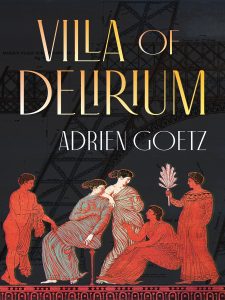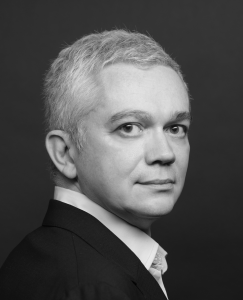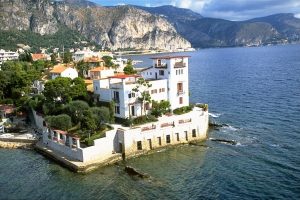Art historian, scholar, and author Adrien Goetz discusses his new novel Villa of Delirium, set in the historic Villa Kérylos on the French Riviera.
For his interview with Reading Group Choices, Adrien Goetz talks about the lure of mysteries, what inspires him at the Louvre, why the past is present (and future), and why useless pursuits are the best ones to follow…
Reading Group Choices: In Villa of Delirium, Achilles returns to Kérylos decades after he left it, in search of a hidden treasure. You’ve also written a series of novels that revolve around art-inspired mysteries. To discover the past, it seems, is to engage in a mystery. Can you speak about that connection?
 Adrien Goetz: I love mysteries, to find the missing piece, to solve puzzles. Villa of Delirium is not a crime novel, of course, but this villa is a setting which lends itself to this type of investigation.
Adrien Goetz: I love mysteries, to find the missing piece, to solve puzzles. Villa of Delirium is not a crime novel, of course, but this villa is a setting which lends itself to this type of investigation.
RGC: Achilles remarks on the childlike energy and excitement with which the Reinach brothers (and Gustave Eiffel) launched their grand projects. Do you feel that way about novel writing?
AG: In all modesty, yes, you’ve got it right. Constructing a novel is like building a house just as you want to, where you alone reign, with the need to invite everyone there once it will be finished.
RGC: One recurring notion in the novel is the pleasure of the useless. Learning ancient Greek, for example, is all the better for not being practical. Theodore Reinach tells Achilles that “it is precisely with what serves no purpose that one achieves great things”. Has that idea been a guiding principle in your own pursuits?
AG: But you intuit all! I’m trying to teach this idea to my students right now at the Sorbonne: to always privilege the useless, to interest oneself in what isn’t “on the syllabus”, to read for pleasure and forget the lists of books that are hard to digest… They think I’m joking!
RGC: Given your knowledge of the Louvre, in particular as editor of its quarterly magazine, Grande Galerie, what spirit or frame of mind would you advise someone to assume as they visit? Where would we find you among its galleries?
AG: Right now there is a gallery that I like very much and which is one of the least visited in the museum. It’s the gallery of Baouît, where an Egyptian church from the paleo-Christian era has been constructed, a very poetic and very beautiful place. It’s there that the action of my new novel begins, an historical crime story this time, Intrigue in Egypt, which has just been published by Grasset. At the Louvre, let yourself be guided by your inspiration and have confidence in chance, and above all come back. Each time, I discover something!
 RGC: Can you talk about the interplay of fact and imagination, and what the fictional character of Achilles helps us learn about the historical figures of the Reinach brothers? Did you feel particular pressure when writing about the Reinachs, Gustave Eiffel, or any of the other real-life artists and cultural icons who appear in the novel?
RGC: Can you talk about the interplay of fact and imagination, and what the fictional character of Achilles helps us learn about the historical figures of the Reinach brothers? Did you feel particular pressure when writing about the Reinachs, Gustave Eiffel, or any of the other real-life artists and cultural icons who appear in the novel?
AG: I wanted to place them at a bit of distance. I had to be an external observer which watches, not understanding everything, and makes hypotheses. I didn’t want to lend to the Reinachs feelings which wouldn’t be correct. Thanks to Achilles, I put myself in the skin of a young man a little naive who is fascinated by what he discovers…
RGC: Given your life’s work and extensive scholarship in the field of art history, do you feel more at home in the past than in the present (or future)?
AG: The past is always here, with us, and hopefully for the future. A novel of Victor Hugo is not a book of the past, it is present in our library. The Villa Kérylos is not a place of the past, it exists today, since we visit it, we enter it, we go there with friends, and where maybe we even make plans… I feel myself at ease there, in our time.
RGC: Villa of Delirium will introduce Anglophone readers to your work as a novelist. Do you anticipate any particular ways in which these readers will respond to the novel? Do you have thoughts about the relationship between a young country like the United States and antiquity?
AG: In the U.S., there are extraordinary homes everywhere that have beautiful stories. I think that the Americans have this sensibility. I trembled when visiting Monticello or the beautiful villas of Newport. Renaissance homes, Trianons, Roman villas have been built in the U.S. The most celebrated and most beautiful are those of J. Paul Getty at Malibu, a Villa Kérylos from the 1970s.

RGC: Forgery versus authenticity is a recurring subject in the novel, most notably in the controversy surrounding the Oblia tiara, which threatens the Reinachs’ reputation. What can the shifting definitions of “real” and “fake” in relation to objects of the past teach us about the current era of fake news and mistrust in information?
AG: It’s one of the subjects of this book, indeed. It’s the question that I would like for visiters to ask themselves when they visit an historic monument: when was what we see really built? In another of my novels, which takes place at Versailles, this theme was already central. The tiara is an evil twin of the villa. I had the chance to hold it in my hands, in the storage of the Louvre. It is truly “too beautiful to be true”, an incontestable masterpiece… from the 19th century!
RGC: The novel makes clear how the First World War brought a blunt, modern end to romantic thinking. Is some of that innocence and idealism recoverable?
AG: In books, perhaps, at least, and it is just as beautiful…
RGC: Theodore Reinach tells his wife that his studies and architectural projects will allow him “to enter the minds of the ancients”. Has your work with art given you similar access? And if so, what have you learned?
AG: Theodore builds his house also so that his wife, his children, can enter his mind. He’s a lonely soul, who grew up locked away in a library. It’s not only a metaphor. We have all felt during our studies these moments where it is difficult to open ourselves to others. Maybe because we are too deep in the spirit of another time, in the understanding of a mathematic or philosophical question. I wanted to try to make this felt to my readers. Everyone at one time has stopped themselves to dream at Pompeii, in Rome, before the Temple of Dendur transported to the Metropolitan Museum, or at the summit of the Empire State Building. These places put us in communication with other eras, they permit unique moments of meditation, of admiration, of sharing! One can experience love stories across centuries when entering these places conceived by the minds of the past. It is what the Romantics knew at the time, when the “poetry of ruins” kindled the spirit.

RGC: Could you have predicted you would write a novel based around Kérylos during your first visit to the villa?
AG: As soon as I entered there, I felt good vibes, and I knew that this house had a thousand things to tell…
Thank you for your questions. They are a true reward for an author !
Read more about Adrien’s novel Villa of Delirium.
Take a spellbinding virtual visit of the Villa Kérylos.
Browse all of the great author interviews on our blog, including other French authors such as Antoine Laurain and Timothée de Fombelle!
Photo Villa Kérylos: Christophe Recoura – CC BY-SA 3.0
Photo mosaic: Hélène Grenier – CC BY-SA 3.o
